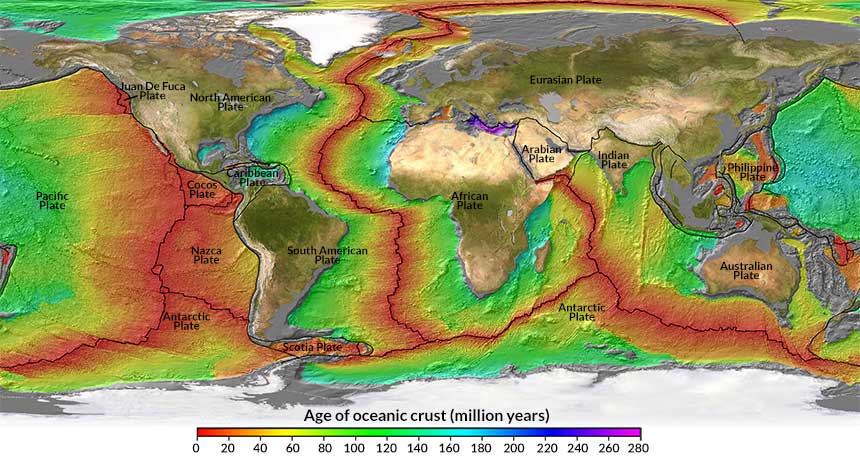
COOLING DOWN Newly formed oceanic crust (redder shaded regions) is thinner on average than older crust, new research shows. This thinning suggests that Earth’s mantle is cooling faster than previously thought.
NCEI/NOAA; R.D. Müller et al/Geochem. Geophys. Geosyst. 2008
- More than 2 years ago
SAN FRANCISCO — Earth’s innards are cooling off surprisingly fast.
The thickness of new volcanic crust forming on the seafloor has gotten thinner over the last 170 million years. That suggests that the underlying mantle is cooling about twice as fast as previously thought, researchers reported December 13 at the American Geophysical Union’s fall meeting.
The rapid mantle cooling offers fresh insight into how plate tectonics regulates Earth’s internal temperature, said study coauthor Harm Van Avendonk, a geophysicist at the University of Texas at Austin. “We’re seeing this kind of thin oceanic crust on the seafloor that may not have existed several hundred million years ago,” he said. “We always consider that the present is the clue to the past, but that doesn’t work here.”
The finding is fascinating, though the underlying data is sparse, said Laurent Montési, a geodynamicist at the University of Maryland in College Park. Measuring the thickness of seafloor crust requires seismic studies, and “you don’t have that everywhere; there’s nothing in the South Pacific, for example.” Still, he said, “it’s amazing that we can see the signature of the cooling of the Earth.” The finding could help explain why supercontinents such as Pangaea break apart, he added.
Earth’s mantle is made up of hot rock under high pressures. As material rises toward Earth’s surface, pressures drop and the rock starts melting. This molten material can spew onto the surface at mid-ocean ridges and construct new crust. When mantle temperatures are hotter, the melt zone is larger and the resulting crust is thicker. Near the upper boundary with the crust, mantle temperatures range from about 500° to 900° Celsius.
Comparing the thickness of oceanic crust of different ages, Van Avendonk and colleagues discovered that 170-million-year-old crust is 1.7 kilometers thicker on average than fresh crust. Chemical analyses of lava rocks suggest Earth’s mantle has cooled about 6 to 11 degrees on average every 100 million years over the last 2.5 billion years. But since the mid-Jurassic about 170 million years ago, the mantle has cooled around 15 to 20 degrees on average per 100 million years, the researchers estimate. While scientists expected the mantle to cool over time as heat left over from Earth’s formation and from radioactive decay dissipates, this degree of cooling was surprising.
Plate tectonics is causing this rapid cooldown, the researchers proposed. The sinking, shifting and formation of plates drive convection in the planet’s interior that shifts heat. This process also controls how fast different regions of the mantle cool. While mantle temperatures below the Pacific Ocean have decreased around 13 degrees per 100 million years, the mantle below the Atlantic and Indian oceans has cooled about 37 degrees per 100 million years.
The difference between the oceans is their distance to continents. The Atlantic and Indian oceans opened when the Pangaea supercontinent ripped apart. Before then, the underlying mantle was covered by continental crust, which served as an insulating blanket that kept mantle temperatures toasty, Van Avendonk proposed. As Pangaea split and the continents shifted, the mantle beneath the young oceans began cooling much faster. Over that same time period, the Pacific Ocean was largely isolated from the continents and cooled more gradually.
The insulating effect of the Pangaea supercontinent could help explain what drives Earth’s cycle of supercontinent formation and breakup, Montési said. Heat may build up underneath supercontinents, ultimately generating a massive rising plume of hot rock that splits the landmass apart. “This could explain why you get a breakup about 100 million years after you get a supercontinent assembled,” he said.






